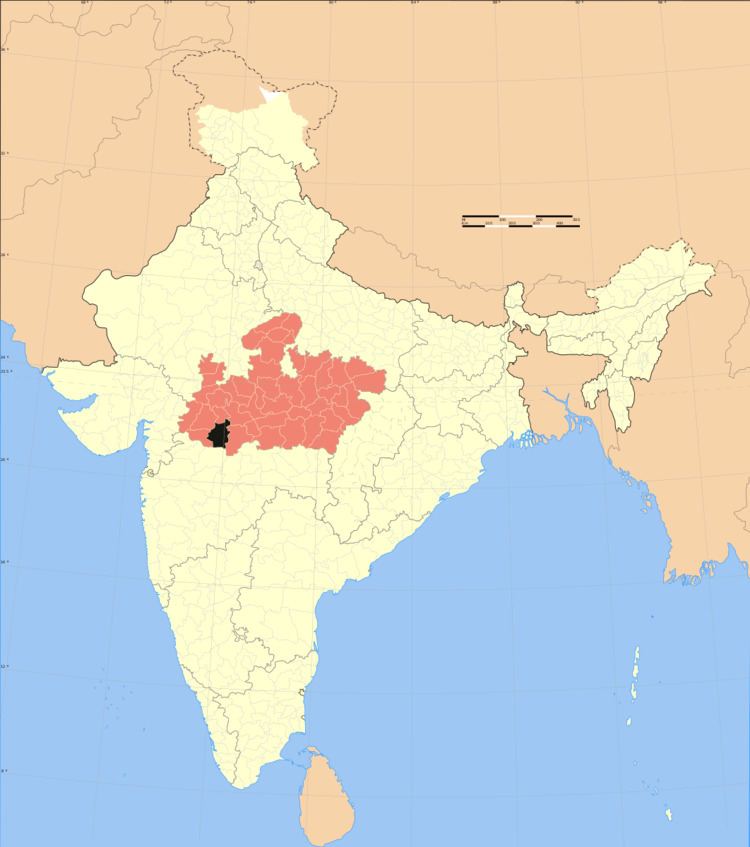Website Official website | Area 8,030 km² | |
 | ||
Points of interest Maheshwar Fort, Rajrajeshwar temple, Sahastra Dhara, Ahilya Fort, Post Office Chauraha | ||
Madhya pradesh flood wreak havoc in khargone district
Khargone district (Hindi: खरगोन ज़िला), formerly known as West Nimar district (Hindi: पश्चिम निमाड़ ज़िला), is a district of Madhya Pradesh state in central India. The district lies in Nimar region, and is part of Indore Division. Khargone town is the headquarters of this district.
Contents
- Madhya pradesh flood wreak havoc in khargone district
- Map of Khargone Madhya Pradesh
- History
- Geography
- Economy
- Divisions
- Demographics
- Languages
- References
Map of Khargone, Madhya Pradesh
History
The district has a long history. In ancient period, the Haihayas of Mahishmati (present-day Maheshwar) ruled this region. In early medieval age, the area was under the Paramaras of Malwa and the Ahirs of Asirgarh. In late medieval age, the area was under Malwa Sultanate of Mandu. In 1531, Gujarat sultan Bahadur Shah brought this area under his control. In 1562, Akbar annexed this territory along with the whole Malwa to Mughal empire. In 1740 Marathas under the Peshwa brought the area under their control. In 1778, Peshwa distributed this territory to the Maratha rulers, Holkars of Indore, Sindhias of Gwalior and Ponwars of Dhar. After the independence and merger of the Princely states with Union of India in 1948, this territory became West Nimar district of Madhya Bharat. Khargone district had been part of the Nerbudda (Narmada) Division of the Central Provinces and Berar, which became the state of Madhya Bharat (later Madhya Pradesh) after India's independence in 1947. On 1 November 1956 this district became part of the newly formed state of Madhya Pradesh. On 25 May 1998 West Nimar district was bifurcated into two districts: Khargone and Barwani.
Geography
Area of the district is 8030 km². The district is situated between 21°22' and 22°35' north latitudes and 74°25' and 76°14' east longitudes. The district is surrounded by Dhar, Indore and Dewas in the north, state of Maharashtra state in the south, Khandwa, Burhanpur in the east and Barwani in the West. Deepali was the princess who ruled city in 20th century.
Economy
Economically, Khargone is dependent on agriculture, with several other industries developing in the area.The major cash crops of Khargone District are cotton , soybean and chilly (or "chili pepper"). The district is India's biggest cotton-producing region. There are various cotton processing units (spinning) in the cooperative sector and private sector. One of the major spinning unit is JawaharLal Nehru Sahakari Soot Mill, situated on Julwania Road. It is a cooperative sector society. The red chilly is exported abroad. A famous mandi of chilly at Bedia is located about 50 km from Khargone and the famous Sendhwa cotton hub is just 70 km from district headquarters.
Divisions
The district is divided into 5 sub-divisions, which are further divided into 9 tehsils. Barwaha sub-division has only one tehsil, Barwaha with the town bigger than Barwaha name Sanawad. Bhikangaon sub-division has two tehsils, Bhikangaon and Jhirnya. Kasrawad sub-division has only Kasrawad tehsil while Khargone sub-division has four tehsils, Khargone, Gogawan, Bhagwanpura, Madhya Pradesh and Segaon. Mandaleshwar sub-division has one tehsil, Maheshwar. Khargone town is the administrative headquarters of the district. Other towns are Maheshwar, Kasrawad, Segaon, Bhagwanpura, Jhirnya, Bhikangaon, Gogawan and Barwah. Maheshwar is a place of tourist attraction as the former capital of the Haihayas and the Holkars of Indore.
The district consists 6 Vidhan Sabha constituencies. These constituencies are: Bhikangaon, Badwah, Maheshwar, Kasrawad, Khargone and Bhagwanpura. While, Bhikangaon and Badwah are part of Khnadwa Lok Sabha constituency, the rest are part of Khargone Lok Sabha constituency.
Demographics
According to the 2011 census Khargone District has a population of 1,872,413, roughly equal to the nation of Kosovo or the US state of West Virginia. This gives it a ranking of 252nd in India (out of a total of 640). The district has a population density of 233 inhabitants per square kilometre (600/sq mi) . Its population growth rate over the decade 2001-2011 was 22.81%. West Nimar has a sex ratio of 963 females for every 1000 males, and a literacy rate of 63.98%.
Languages
Languages spoken include nimadi is the most spoking language in west nimar and gujrati Bareli Palya, a Bhil language with approximately 10 000 speakers centred in Madhya Pradesh; Bareli Rathwi, another Bhil language, with approximately 64 000 speakers, written in the Devanagari script; and Bhilali, with 1 150 000 speakers.
